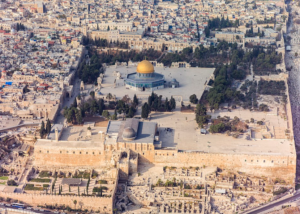 Anyone who has seen the ancient, massive stone walls of the so-called “temple mount” will at some point think about what Jesus said regarding the destruction of the temple—that no stone would be left upon another as stated by Jesus in Matthew 24:2 and Mark 13:2. If the walls were part of the temple compound, then why are there still all those stones left?
Anyone who has seen the ancient, massive stone walls of the so-called “temple mount” will at some point think about what Jesus said regarding the destruction of the temple—that no stone would be left upon another as stated by Jesus in Matthew 24:2 and Mark 13:2. If the walls were part of the temple compound, then why are there still all those stones left?
Did Jesus lie? Was his statement just a hyperbole (an exaggeration to make a point)? The excuse is usually given that in Mark 13:2, Jesus was speaking of the temple buildings only, not the outer walls, because Jesus states: “Seest thou these great buildings? There shall not be left one stone upon another, that shall not be thrown down.”
I would argue that anything that has been built is technically a “building.” The stone walls consist of four walls. You could say it is a building without a ceiling. However, it really doesn’t matter, because in another passage, Jesus states very specifically that “not one stone would be left upon another” of the entire City of Jerusalem in Luke 19:42-44:
And when he was come near, he beheld the CITY [Jerusalem], and wept over it, Saying, If thou hadst known, even thou, at least in this thy day, the things which belong unto thy peace! but now they are hid from thine eyes. For the days shall come upon thee, that thine enemies shall cast a trench about thee [Jerusalem], and compass thee round, and keep thee in on every side, And shall lay thee even with the ground, and thy children within thee; and they shall not leave in thee [Jerusalem] one stone upon another; because thou knewest not the time of thy visitation.
There is no indication in this passage (or the Matthew and Mark passages) that Jesus was employing hyperbole (exaggerating), so either he was mistaken or lying, (both impossible) OR those stone walls were never a part of Jerusalem nor a part of the temple complex in the first place. As discussed in Part 1, the Bible makes it clear that the temple was in the City of David, not on the geographical area incorrectly called the temple mount.

